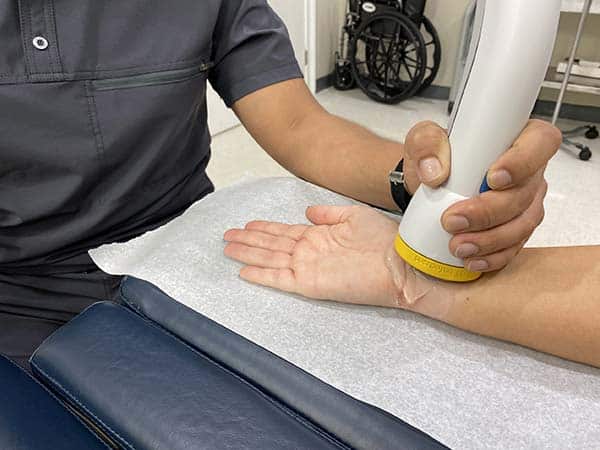
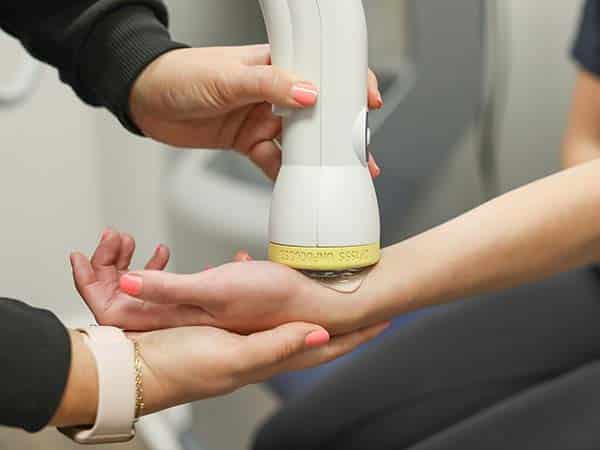
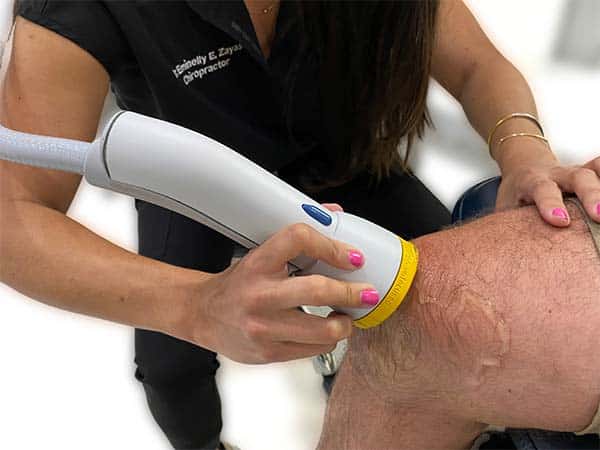
From serious sports injuries causing tissue damage to bone issues and stiffness that comes with age, living with pain is, well, a pain. But it's more than that - it's a stressful, often upsetting way to get through your day, month, and year. Have you ever tried to get out of bed with sore, stiff knees? Most folks would rather just get back in bed. Think you might try exercising with plantar fasciitis? Don't plan on running far or doing cardio for very long. Torn rotator cuff? Without proper treatment, your life might not ever be the same.
Living with pain and the inevitable issues that come with age can seriously affect your wellbeing and happiness. Sure, you could wake up every morning and rely on addicting medications to help you move. Or, you could risk further injury and damage with invasive surgeries that require long periods of recovery and downtime. But those can't be the only two options for treatment, can they?
Fortunately, a new, natural, non-invasive treatment for pain is revolutionizing the medical industry and transforming people's lives. It's giving athletes, average folks, and people of a certain age a reason to be hopeful. It's called Softwave therapy, and unlike many fly-by-night medications and sketchy treatments, it's backed by science and provided by Elite Healthcare Physical Medicine.
If you're barely making it through the day suffering from chronic pain, this FDA-approved drug-free treatment may be for you. Softwave therapy has already been used by thousands of people around the country living with issues like shoulder pain, knee pain, and plantar fasciitis. You could be next.
Though its popularity has only grown in recent years, Softwave therapy - also known as shockwave therapy - has been around for years. In fact, the first systematic study into the benefits of shockwave therapy took place way back in 1950. So, what is Softwave therapy?
Softwave therapy is a method of treatment that works incredibly well for mobility rehab, pain relief, and full-body recovery, usually from chronic pain or injuries. Softwave therapy uses a device emitting low-energy soundwaves that target a patient's injured area. These low-intensity waves boost blood flow and kickstart your body's natural healing processes, relieving long-term pain and helping your body to heal a wide range of injuries and conditions.
The main targets in the body include bones, tendons, and other soft tissues, which are encouraged to regenerate and repair via the shockwaves. Often, shockwave therapy is used in conjunction with other non-invasive treatments like chiropractic care, which we offer at Elite Healthcare Physical Medicine. The results are often incredible, leaving patients wondering why they never tried Softwave therapy before.
Softwave therapy works especially well for:

Better Blood Flow

Collagen Stimulation

Reducing Inflammation

Kickstarting cell growth and healing factors

Breaking down build-ups of calcium
With FDA clearance, little-to-no side effects, and quick application time, Softwave therapy is a welcome alternative for people suffering from pain. Who wants to spend weeks or months recovering from a surgery that might not even work? Likewise, who would want to become dependent on over-the-counter or, even worse, prescription pain meds? Living a life of addiction is a road nobody wants to go down.
Softwave therapy represents a revolution in non-invasive pain treatment; best of all, it's highly effective. Independent studies prove that shockwave therapy helps with pain. 65-91% of patients using shockwave therapy experienced real-deal improvements in damaged muscle and bone tissue, solving their mobility problems and drastically reducing pain. It almost sounds too good to be true, but as many patients at Elite Healthcare Physical Medicine will tell you - it isn't.
Book AppointmentSome of the most common conditions that Softwave therapy treats include:

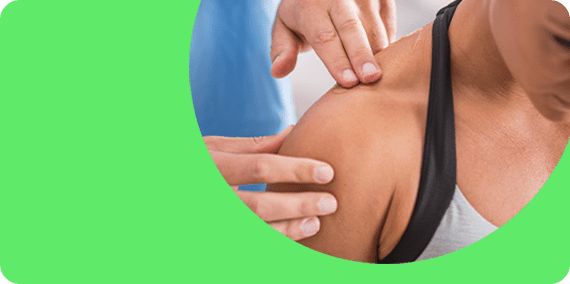

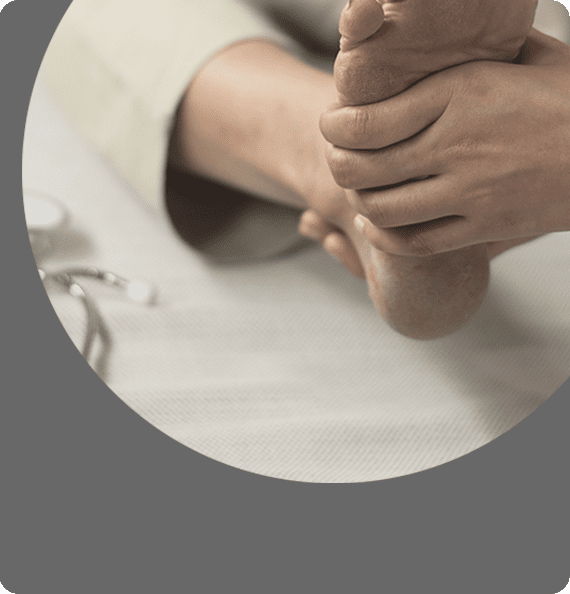




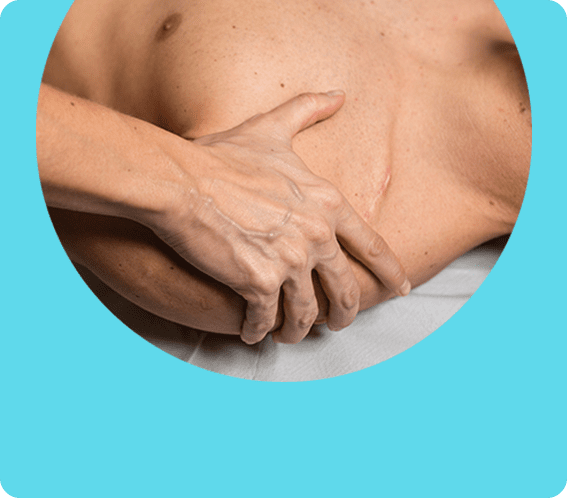
When you get up in the morning and go to the bathroom to brush your teeth, do you notice a stabbing, sharp pain near your heel? Does the pain go away once you have a chance to walk around? If so, you could have plantar fasciitis. According to the American College of Foot and Ankle Surgeons, this painful condition is quite common. About two million people suffer from plantar fasciitis every year, and almost 10% of all people will experience the condition at least once in their life.
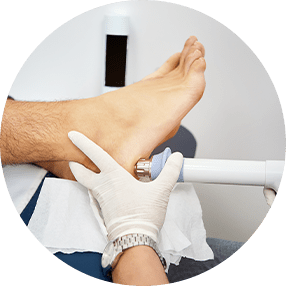
This common foot issue happens when the plantar fascia - a fan-shaped tissue near your heel - gets inflamed. The plantar fascia is a thick strip of connective tissue that links your toes to your heel bone, helping to preserve the arch of your foot. When this band is strained, it causes intensely sharp pain, usually in the morning when you wake up and plant your feet on the floor.
Most folks ignore plantar fasciitis because the pain eventually goes away throughout the day. However, if left untreated, plantar fasciitis can lead to weakness and chronic pain, which may affect daily walking.
Some causes of plantar fasciitis include:
The short answer to this question is not really. Patients with plantar fasciitis will ice the affected area with little-to-no relief since they spend so much time on their feet. It's hard to rest an achy heel if you've got a job that requires you to be on your feet. Anti-inflammatory meds like Advil don't work all that well, either. They may provide temporary pain relief, but in terms of a long-term solution, taking these drugs will cause major side effects.
Book AppointmentWhen more conservative treatment options like ice and over-the-counter meds don't work, most doctors turn to ultra-expensive orthotics, steroid injections, or invasive surgery. For the average person, those options fail on all fronts, as they carry risks for side effects and may even cause the issue to worsen.
Instead of going under the knife or changing their daily routines, many people suffering from plantar fasciitis are turning to Softwave therapy for relief.
During a shockwave therapy session, our expert providers use a special probe to deliver pressure waves to inflamed tissue. These waves trigger natural healing processes causing new blood vessels to form. In turn, oxygen is supplied to the affected area, reducing inflammation and causing healthy cells to regenerate. Shockwave therapy also produces collagen, which is crucial for connective tissue health.
With just a few visits, many patients find long-term relief from plantar fasciitis without relying on strange drugs or harmful surgeries.
Living with knee pain is just miserable. From knee tendonitis to osteoarthritis, knee pain can prevent you from enjoying activities and affect your day-to-day life. Your knee is a joint comprised of cartilage, bone, ligaments, and fluids. Tendons and muscles within the knee help the joint move. When one of these crucial knee structures is hurt or compromised, it results in knee pain and long-lasting knee problems. This, in turn, leads to difficulty walking at best and debilitating knee issues at worse.
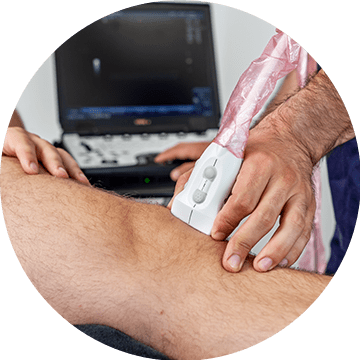

If you're an active person or somebody who plays sports often, you're probably all too familiar with knee pain - especially common conditions like patellar tendinopathy. Also called "jumpers knee," this issue happens at the patellar tendon, which is found on the front of the knee just under the knee cap. When living with this condition, most patients experience pain around the kneecap or lower down on the leg around the tibia.
In addition to injuries and issues like jumper's knee, everyday wear and tear will cause knee pain over time. With time, this knee pain can develop into arthritis. If your knees are swollen, painful, or stiff, you may have arthritis in your knees. Regardless of the kind of knee pain you're experiencing, treatment options have been limited to agonizing surgeries and addicting pain medications. But that all changes with shockwave therapy for knee pain in West Ashley, SC.

Though no two knee pain problems are exactly the same, shockwave therapy has been shown to be highly effective for knee pain. In fact, many patients at Elite Healthcare Physical Medicine find relief after just one session. Many times, sessions can be completed in as little as 30 minutes. So if you want to find relief for knee pain on your lunch break, that's definitely possible.
As is the case with plantar fasciitis, Softwave therapy works by sending sound wave and low-energy impulses to the affected area of your knee. These pulses stimulate your body's healing factors, which can help regenerate and repair damaged tendons and tissues. Softwave therapy for knee pain is especially promising for people who have tried other treatments - like surgery and pain meds - with disappointing results.
Benefits include:
Several studies and reviews prove that Softwave therapy can be very beneficial for people suffering from knee pain problems like jumper's knee. A study involving 66 patients with knee pain found that they enjoyed a significant improvement in their reported pain levels with Softwave therapy. In fact, knee pain was reduced by nearly 50% after a single month. When combined with other regenerative and physical therapy treatments at Elite Healthcare Physical Medicine, your days of living with knee pain are numbered.
Book AppointmentHere's a fact for you to consider: Every joint that you have in your body plays a part in your day-to-day life. But when we think of joint issues, we typically jump to knee issues. However, your knees aren't the only joints in your body to go through wear and tear. Your shoulders experience just as much, if not more, wear and tear than your knees. We put a strain on our shoulders just about every time we use or move our arms. Our shoulders play a pivotal part in living a normal life. When they begin to deteriorate over time due to age or overuse, it creates a litany of painful problems.
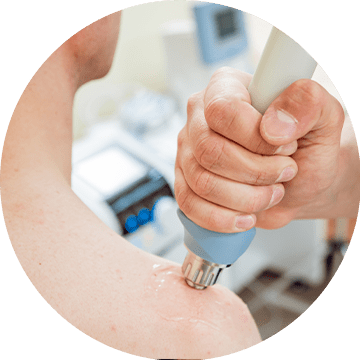

There are many causes of shoulder pain, like deterioration, inflammation, and trauma. Of the many painful shoulder conditions affecting Americans yearly, rotator cuff tendonitis and arthritis are very common. Also called calcific tendinitis, rotator cuff pain is caused by built-up calcium deposits on the shoulder's tendons, which connect your rotator cuff to nearby muscles and bones. This painful condition is usually linked to sports, like basketball and volleyball, or in professions requiring repetitive movements, like in the plumbing industry.
Some common symptoms of shoulder pain and rotator cuff tendinitis include:
Though strengthening exercises and some medications provide temporary relief for shoulder pain, they're not meant as long-term solutions. Luckily, Softwave therapy for rotator cuff pain in West Ashley, SC, can help.
Shockwave therapy has been shown to work wonders for shoulder pain. Low-intensity shockwaves break up calcium deposits and jumpstart your body's healing processes, stimulating blood flow and healthy cell growth. Shockwave treatment is especially effective for long-term shoulder pain since it releases stem cells, sends growth factors to the affected area, and boosts capillary production. Shockwave therapy has also been shown to break down scar tissue and eliminate trigger points, all of which decrease shoulder pain. This relief is most often long-lasting, unlike other treatments like medications and injections.
Many studies support the efficacy of Softwave therapy for shoulder conditions like rotator cuff pain and calcific tendonitis of the shoulder. In a study of 84 patients living with long-term rotator cuff tendonitis, participants in the treatment group saw a significant decrease in the intensity of their shoulder pain. Another study related to shockwave therapy for calcific tendonitis found that 86.6% of patients experienced fewer calcifications.
If you're having to live with rotator cuff pain or another type of shoulder issue, choosing Softwave therapy may be your best course of action.
Book AppointmentWhether you're sick of living with intense heel pain from plantar fasciitis, the mobility issues associated with knee pain, or the day-to-day struggles of rotator cuff degeneration, you'll find hope at Elite Healthcare Physical Medicine. Unlike some medical clinics, our team of doctors and specialists focus on an integrative, multidisciplinary approach to healing. Instead of relying on addictive medications and invasive surgeries, we prefer to address the underlying causes that our patients face.
We combine several all-natural pain relief therapies so that your shoulder pain, knee pain, joint pain, and foot pain go away for good. We resolve pain by using healing treatments that restore function and improve mobility for the long term. Our state-of-the-art regenerative medicine treatments, used hand-in-hand with proven chiropractic techniques, will stimulate your body's healing power from within. If your pain is related to muscles, nerves, and bones, our doctors can help you overcome discomfort, injury, or medical conditions affecting these systems.
If you've been unable to resolve your pain or have become dependent on painkillers to cope, Softwave therapy may be the natural solution you need. It all starts with a quick call to our office, so we can begin to understand your needs. When you come for your first visit, our doctors will find the personalized treatment you need so that you can manage your pain in a non-invasive and drug-free environment manner.
Book AppointmentCHARLESTON, S.C. (WCIV) — West Ashley is home to South Carolina’s first-ever food forest.Funded through a $50,000 grant from the South Carolina Forestry Commission, Charleston Parks Conservancy launched the project with the City of Charleston and other partners to provide free and nutritious options in areas struggling with food insecurity.“In the end, this will end up producing about 30,000 pounds of fresh organic produce, in a community that doesn't have great access to healthy foods,” said Darlene Hea...
CHARLESTON, S.C. (WCIV) — West Ashley is home to South Carolina’s first-ever food forest.
Funded through a $50,000 grant from the South Carolina Forestry Commission, Charleston Parks Conservancy launched the project with the City of Charleston and other partners to provide free and nutritious options in areas struggling with food insecurity.
“In the end, this will end up producing about 30,000 pounds of fresh organic produce, in a community that doesn't have great access to healthy foods,” said Darlene Heater, executive director of Charleston Parks Conservancy.
Rows of more than 75 plants, ranging from nut trees to berry bushes, line Mulberry Park in West Ashley.
READ MORE: "Hendrick Automotive Group donates $100,000 to Lowcountry Food Bank."
The first in the state, Charleston’s new food forest will provide free, fresh produce to those who need it most.
“What's beautiful about a food forest is that anybody can access it at any time. So, you're not relying on someone's opening hours or the availability to be able to go to a source to get food,” Heater said. “It is in the community and available to the community for whoever needs it.”
The forest features seven tiers of agriculture and will begin producing roughly $25,000 worth of food annually in the first five years.
The conservancy has worked with several local groups, like Slow Food Charleston, to make the flagship project come to life.
“To help bring good, clean, and fair agricultural products to our community, to communities that may not have access to them. To have them engage in a manner that is enriching,” said Kellie Holmes, co-chair of Slow Food Charleston.
READ MORE: "Hansley's Free Fridge project is fighting food insecurity in South Carolina."
Accessibility is at the root of it all.
The food forest is in the Ardmore neighborhood, a lower-income area that could be categorized as a food desert. It isn't an uncommon issue. Around 40.5 million Americans live in USDA-designated food deserts nationwide.
“Mulberry Park is an ideal location. It is a community that, though it has some grocery stores in its vicinity, they are not necessarily grocery stores that everyone in the community can afford to go to,” Heater explained.
Located off the Bikeway, Charleston Parks Conservancy hopes the food forest will feed not only its closest neighbors but the greater West Ashley and Charleston area.
Pluck an apple, cut some herbs or pick some berries at South Carolina's first food forest, a new free-of-charge grove being built in the Ardmore community.With an expected seven stories of canopies and an estimated $25,000 annually in produce by its fifth year, Charleston Parks Conservancy director Darlene Heater acknowledged it's a remarkable undertaking for the local nonprofit."It's creating access ...
Pluck an apple, cut some herbs or pick some berries at South Carolina's first food forest, a new free-of-charge grove being built in the Ardmore community.
With an expected seven stories of canopies and an estimated $25,000 annually in produce by its fifth year, Charleston Parks Conservancy director Darlene Heater acknowledged it's a remarkable undertaking for the local nonprofit.
"It's creating access in food deserts but creating it in a way that is low-maintenance and little barrier for people to be able to participate in it," Heater said.
The food forest on Mulberry Street near Grech Street, and off the West Ashley Bikeway, is being funded by a $50,000 grant from the South Carolina Forestry Commission.
While the conservancy is handling the horticulture, the City of Charleston's parks department is working to excavate the land, add pathways and install a new playground at the park. It is one of several conservancy projects this year, in addition to working with the city to manage 24 parks on the peninsula, on James Island and in West Ashley.
Parks Department director Jason Kronsberg compared the collaboration between the city, the conservancy and the community to a three-legged stool. The conservancy liaises with the neighborhoods, like Ardmore for the food forest, and then fundraises with them before going to the city to bring a project to life.
The food forest is intended to help the Ardmore neighborhood, recently identified in the Charleston parks master plan as a community of high need, along with the surrounding community.
Besides providing free access to produce, the forest can help people better understand where their food comes from, Kronsberg said. It's also an opportunity for folks to lend a hand with some maintenance.
"The parks are owned by everybody," Kronsberg said.
The project will not be without its challenges, though. As the weather in Charleston gets more severe, Heater said that the conservancy will need to tend to the forest carefully and make sure plants or produce don't wash away.
Teaching the community how to use — and not overuse — the one-of-a-kind forest will take time, too.
The conservancy plans to lean on its volunteer base to maintain the forest, such as harvesting, packing and sending excess produce to local nonprofits. There will be no constraints on harvesting to start, as to not adversely impact food accessibility, Heater said. Part of it will be trial and error, and much of the plan is flexible based on the demand the conservancy sees for certain produce.
"What we may learn is that this community really loves sweet potatoes but doesn't care as much about turnips," Heater said. "So let's look at how we can expand growing our sweet potato patch so that we can continue to serve the people adequately who most need it."
This spring will mark the first planting of the fruit trees, brambles and herbs. Heater said that best practices dictate not harvesting during the first year, so by the second year the conservancy expects to have herbs, mushrooms, brambles and possibly bananas to harvest.
By the fifth year, with an estimated 70 trees bearing fruit, Heater said she expects 10,000 pounds of produce.
The food forest comes two years after the adoption of a new Charleston parks master plan and months after the overwhelming approval of a bond referendum question last November.
"Citizens spoke loudly and clearly that they supported the referendum and improved park spaces," Kronsberg said. "Coming out of COVID, when parks became critical infrastructure, it was natural that there was that much support for a referendum."
As the Ardmore food forest begins to yield, relieving supply-chain issues might just become an additional perk. And in a world reshaped after the pandemic, the food forest is one project that shows how to branch out from the traditional park.
There are many challenges to growing fruit, from soil quality to harsh climates for plants and, often, these plantings do not last a particularly long time. Yet there is hope to have fresh fruit in the landscape, and the way this is accomplished is by planting more unique and lesser-known fruit trees and shrubs. One shrub is not only a perfect choice for growing here, but it also has excellent ornamental value as well: the blueberry.
Blueberries are a group of plants usually in the Vaccinium genus, most of which are native to North America. They are members of the Ericaceae family, along with the Rhododendron genus that includes azaleas. There are dozens of species and even more cultivars of blueberries, making selection somewhat confusing.
That being said, there are two main types grown here in the Lowcountry. There is the southern highbush blueberry, V. corymbosum. This group has low chill hour requirements and has decent heat tolerances. Then there is the rabbiteye blueberry, V. virgatum, which is more adaptable to the state and is a perfect choice for the home garden. The rabbiteye blueberry is the preferred species here in the Lowcountry due to its adaptability, productivity and pest tolerance.
As mentioned previously, there is a major consideration when selecting the cultivar of blueberry: chill hour requirements. Chill hours refers to the number of hours below 40 degrees Fahrenheit the plant needs in order for flowers to develop. If the required number of hours is too high, then it would be unlikely the shrub will ever produce flowers or fruits in the Lowcountry. If the required number of hours is too low, then the flowering may commence too early in the year at the first sign of warm weather and thus be damaged by the subsequent frosts. Here, along the coast, the approximate number of hours is 400-600.
The other thing to keep in mind is that, while blueberries are considered self-fertile, fruit production increases with cross-pollination. Rabbiteye blueberries have issues with self-incompatibility, making cross-pollination necessary in order for better fruit development. Ideally, two or more cultivars are required for proper fruit production. Rabbiteye blueberries have the greatest degree of self-incompatibility, whereas southern highbush are better suited to be self-fertile — though it is still recommended to have two or more types.
Growing and maintaining blueberries is relatively simple once they are established, but proper site selection is essential. Blueberry plants prefer well-drained, acidic soil to thrive. These are by far the most common issues with stunted blueberry plants. The pH recommendation for blueberries is between 4.5 and 5.5. A pH above a 6.0 can stunt the plant permanently. It is imperative to have a soil test done before planting to determine the pH. Once a shrub is stunted due to improper pH, the plant generally does not recover.
Pruning when first planted is paramount. This enhances survivability and encourages more vigorous growth the following year. It is also necessary to remove any shoot tips that have flower buds (swollen rounded buds) for the first couple of seasons. This spurs vegetative growth, since reproduction requires tremendous energy.
By the third season, there should be a multitude of shoots, which will greatly increase flower production. As the plants grow after being established, it is recommended to prune consistently to keep down insect issues as well as encourage healthy growth. The best time to prune established shrubs is from January to March, before the buds set.
One of the best aspects of this group of fruit-bearing shrubs is not only the ease of care and the overall value added to any landscape but the ecological benefit they provide. As mentioned previously, blueberries are native to North America, and with that comes important relationships with native pollinators. Blueberries, in particular, have a group of bees, known as blueberry bees. These bees need the flowers of the Vaccinium genus. The importance of planting native plants cannot be overstated, and this a great way to bring any landscape one step closer.
CHARLESTON, S.C. (WCSC) - Residents who live near one West Ashley development learned more about the future of their community during a meeting hosted by developers.Cameron Property Company, the company overseeing the development of 26 acres near the Essex Farms community, invited residents to share their concerns and provide input at a meeting Thursday night.The 26-acre lot runs from Essex Farms Drive, down Skye Drive and extends to Dorothy Drive.Developers were accompanied by Charleston city officials representing the ...
CHARLESTON, S.C. (WCSC) - Residents who live near one West Ashley development learned more about the future of their community during a meeting hosted by developers.
Cameron Property Company, the company overseeing the development of 26 acres near the Essex Farms community, invited residents to share their concerns and provide input at a meeting Thursday night.
The 26-acre lot runs from Essex Farms Drive, down Skye Drive and extends to Dorothy Drive.
Developers were accompanied by Charleston city officials representing the council, planning department, and traffic department to discuss what potential businesses residents could expect to see.
During the meeting, community members said they were relieved to learn that the developer withdrew its request to change the zoning language to include drive-thru windows at restaurants.
The developer is in talks with a grocery store and gas station, but plans have not been finalized.
Some residents said they are less than pleased about the big changes coming to the Essex Farms community.
Residents also expressed concerns about traffic congestion and the potential for a gas station to be built on the property.
“Tonight’s the first time we’ve heard gas station. That was a shock for all of us. When we purchased our properties, we were told specifically that a gas station wasn’t allowed to be there,” resident Kellie Kinard said.
Development Manager Collins Moe said he wants community input but that the company has the right to build to the zoning order, which does allow a grocery store and gas station.
“We’re going through the appropriate city of Charleston permit steps which require traffic studies. Things that outline what we’re proposing to make sure they meet all the standards with the county, the state, and the city, more importantly, based on where this property lies. At the end of the day, we’re still very far out,” Moe said.
Kinard said she is disappointed and was left with even more concerns and questions.
“I think my husband and I are going to have a serious conversation about whether or not we’re going to list our home. Which is really unfortunate because we love our neighborhood. We have great neighbors, but we do not want this type of development that they’re talking about potentially literally within several feet of our driveway,” Kinard said.
City officials stated that this development was approved many years ago and the zoning goes back to 1997.
Copyright 2024 WCSC. All rights reserved.
The wide land west of the Ashley River is home to comfortable tree-lined streets with rows of homes, highways flanked by businesses and malls, villages like Avondale and emerging plans for revitalization.With a 2022 population of 83,996 people, West Ashley is the epicenter of Charleston, even though most people consider the peninsula to be more population.“What makes West Ashley special is the people,” said West Ashley Realtor Shana Swain, a former bartender with connections throughout the suburb. “It’s ...
The wide land west of the Ashley River is home to comfortable tree-lined streets with rows of homes, highways flanked by businesses and malls, villages like Avondale and emerging plans for revitalization.
With a 2022 population of 83,996 people, West Ashley is the epicenter of Charleston, even though most people consider the peninsula to be more population.
“What makes West Ashley special is the people,” said West Ashley Realtor Shana Swain, a former bartender with connections throughout the suburb. “It’s where the heart of Charleston is.”
West Of newspaper editor Lorne Chambers agreed, describing residents as having a “scrappy spirit.”
“They are not your traditional downtown Charleston people, but they are real Charlestonians,” he said. “In a way, this is the original Charlestown,” he said. “You have a lot of people over here who have a lot of pride in their community and hope for a better tomorrow.”
Dominated before World War II by farms and pastures, West Ashley bloomed into a middle-class suburban haven replete with everything from mind-numbing rush-hour traffic to chain stores that you can find in Columbus, Ohio.
But with a controversial development project being discussed at the former Piggly Wiggly site on Sumar Street and Ashley River Crossing, a planned pedestrian bridge connecting West Ashley and downtown, a question is what direction is the suburb headed.
The West Ashley Revitalization Committee has been spearheading the suburb’s path toward development. The committee’s Plan West Ashley aims for ambitious changes from economic development to flood prevention.
The Sumar Street development project was postponed in June, causing doubts about the strength of the committee’s plans.
City Councilman Karl Brady represents outer West Ashley. A board member of the West Ashley Revitalization Commission, he said West Ashley projects like the Sumar Street development project, were voted down by people who don’t have a vision for the future.
“They see West Ashley as it is but not as what it could be,” he said.
Brady, who currently is running for reelection, said that in revitalization it is important to remember where West Ashley started. It was the birthplace of Charleston when settlers landed at Charles Towne Landing in 1670.
“I think one thing lost on a bunch of people is that West Ashley is the birthplace of Charleston. That’s how we should treat it.”
Chambers, a former Charleston City Paper employee, said West Ashley is planning in the right direction, but there is not much to show for it.
“In people, you are seeing this shift away from these traditional big-box stores towards giving more community pride,” he said. “But we have to stay the course.”
Chambers said the community has historically wanted more than malls and commutes, but often ended up with Walmarts and chain businesses regardless.
Malls, he said, are a product of West Ashley’s suburban boom in the 1980s. The “retail apocalypse” of the 2010s crippled them. Now, West Ashley has a lot of vacant lots. Chambers said because the area is growing, some residents want to shed the concrete.
“Most citizens in West Ashley didn’t want another mall or gas station,” he said.
Donna Jacobs is a West Ashley historian and author. As a former board member of Plan West Ashley, Jacobs noticed a generational difference in what residents plan for their neighborhoods.
Jacobs said the West Ashley area has been split between two different models of how to live and build. It also is split between two different generations of Americans and what they want for the future.
In many ways, these splits are between those “inside the loop” and those “outside the loop,” meaning those who live north of the swath cut by Interstate 526 and those who live south of it — an area generally with more land and open space.
She said those who live inside 526 advocate for a walkable Avondale plan. But those outside of the interstate often want to keep West Ashley’s traditional shopping centers.
“Inside the loop, some of these younger residents would happily ride their bikes to work every day and walk their kids to school, regardless of the weather,” she said.
But others see cars as their primary way of commuting, “They kind of expect those old West Ashley malls to drive to,” she said.
Jacobs said the diverse lifestyles and history of West Ashley was a strength for living in the area. She added she thought West Ashley was a nice place to live regardless of whether you believe in the Avondale approach or the mall.
Alex Nettless, a former City Paper intern, is a student at Elon University.
*Multiple locations
Population 83,996
Ethnicity68% White26% Black3% Hispanic
Median age 38.7
Median household income $68,898
Percent above $100,000 31%
Households below poverty line 10%
Households above $200,000 7.6%
Households 36,864
Occupancy52% owner-occupied40.0% rental7.7% vacant
Education19.1% are high school graduates.30.7% have bachelor’s degrees.16.5% have graduate degrees.
Apparel and services $82M
Education $65M
Entertainment, Rec $121M
Food at home $201M
Food away from home $144M
Health care $213M
Household furnishings $83M
Shelter $734M
Travel $89M
Help keep the City Paper free.
No paywalls.No newspaper subscription cost.Free delivery at 800 locations from downtown to North Charleston to Johns Island to Summerville to Mount Pleasant.
Help support independent journalism by donating today.
CHARLESTON, S.C. (WCBD) — Charleston city leaders are moving forward with plans to redevelop a shopping center on Sam Rittenburg Boulevard in West Ashley.The City of Charleston’s Design Review Board gave conceptual approval on Monday to a new Publix grocery store and retail space that will be built in the Ashley Landing Mall shopping center where a Publix currently sits.The existing Publix is located closer to Sumar Street and was built in the 90s. The new plans are to move the grocery store to the opposite side of ...
CHARLESTON, S.C. (WCBD) — Charleston city leaders are moving forward with plans to redevelop a shopping center on Sam Rittenburg Boulevard in West Ashley.
The City of Charleston’s Design Review Board gave conceptual approval on Monday to a new Publix grocery store and retail space that will be built in the Ashley Landing Mall shopping center where a Publix currently sits.
The existing Publix is located closer to Sumar Street and was built in the 90s. The new plans are to move the grocery store to the opposite side of the property closer to Charlestowne Drive and add new retail and restaurant space next door.
There is currently a 130,000-square-foot building in that spot, which includes businesses like Dollar Tree and Big Lots inside. The Design Review Board also moved forward with the approval of a partial demolition of the shopping center, which includes these businesses. Robert Summerfield, the city’s Director of Planning, Preservation and Sustainability, said the leases for the businesses were not renewed in preparation for the redevelopment of the area.
Summerfield added that the plans to revamp the shopping center are in line with the city’s goals to revitalize parts of West Ashley.
“This is right in line with the ideas for the plan, it keeps a major shopping experience with the grocery store right there — keeps it anchored in the community and in that shopping center for those neighborhoods in that area,” he explained.
However, Suzanne Germroth, who lives in Charleston, said she is concerned about the neighborhood losing the businesses currently there because of the project.
“A lot of people rely on these discount stores to maintain their livelihood and what they can afford,” she said. “And I don’t understand why this perfectly wonderful building here has to move across the street.”
Summerfield said the current Publix will stay open until the new one is complete, and the plans for what will happen with the existing Publix building have not been decided.
“Publix has actually done this in a number of places in the markets that they work in. You know they’ll close the store one night in its current space and they’ll open the next morning in the new space,” he said. “In the old space, that again will be I believe in phase two of their development plan.”
This was the first time the conceptual plans for the project went in front of the Design Review Board. The next step for the project will be a preliminary review.
